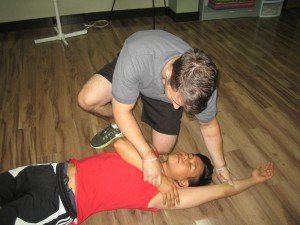
Do you need first aid certification that meets WorkSafe BC requirements? Do you need to attend a two-day first aid course that includes CPR and AED training? Do you need certification that is valid throughout Canada for 3 years? Customers looking for all of these options can register for a course with Victoria First Aid. This training provider trains individuals with varying backgrounds including doctors, nurses, health care professionals, medical school students, life-guards, fire-fighters, paramedics, nursing students, security guards, construction workers, oil and gas workers, teachers, fitness workers, community centre employees, caregivers, daycare workers and many more. Learn the latest cardiopulmonary resuscitation (CPR) techniques as provided by the International Liaison Committee on Resuscitation (ILCOR) and the American Heart Association (AHA). Other courses available with Victoria First Aid include on-line WHMIS and TDG training and food safe level 1 courses. To register for any
Contact Information
You can contact Victoria First Aid using the information below.
- Website: http://firstaidcprvictoria.ca
- Telephone:1-888-870-7002
- Email: info@firstaidcprvictoria.ca
Are Private Classes Available?
Yes, Victoria First Aid proudly offers private courses for small groups, companies and businesses. Competitive rates are available for group private lessons. Instructors can come to your facility or a private course can be held at the centrally located training centre. To inquire about or book a private course use the contact information posted above.
Are Re-Certifications Available?
Yes, participants that need to renew expiring childcare or standard first aid awards can attend a shorter and cheaper re-certification course. These classes are available several times per week. Ensure that you meet the necessary prerequisites prior to registering.
What Will I Learn in a CPR Course?
Participants that attend first aid and / or CPR certification courses will learn about the following CPR topics:
- How to stay safe during an emergency
- How and when to use barrier devices and personal protective equipment
- How to manage conscious choking victims
- How to manage unconscious fully obstructed airway victims
- How to manage non-breathing unconscious victims
- How and when to use an automated external defibrillator
- Legal implications of first aid and CPR
- How to provide effective CPR with and without ventilations
- How to manage victims of shock and varying circulatory emergencies such as heart attacks, angina and stroke
Be prepared for any emergency by enrolling in a course with Victoria First Aid today.
http://www.youtube.com/watch?v=vXim8rU7lY8
Did You Know?
ACL injury signs and symptoms
An ACL (anterior cruciate ligament) is the most common sports injury by people who play basketball, tennis, and other sports that stop and change direction suddenly. When the ligament tears, it can cause severe pain and swelling, and render the knee unusable. Signs and symptoms of an ACL tear are:
- A “pop” from the knee when the person gets injured
- Severe pain
- Inability to bear weight on the injured knee
- Swelling
